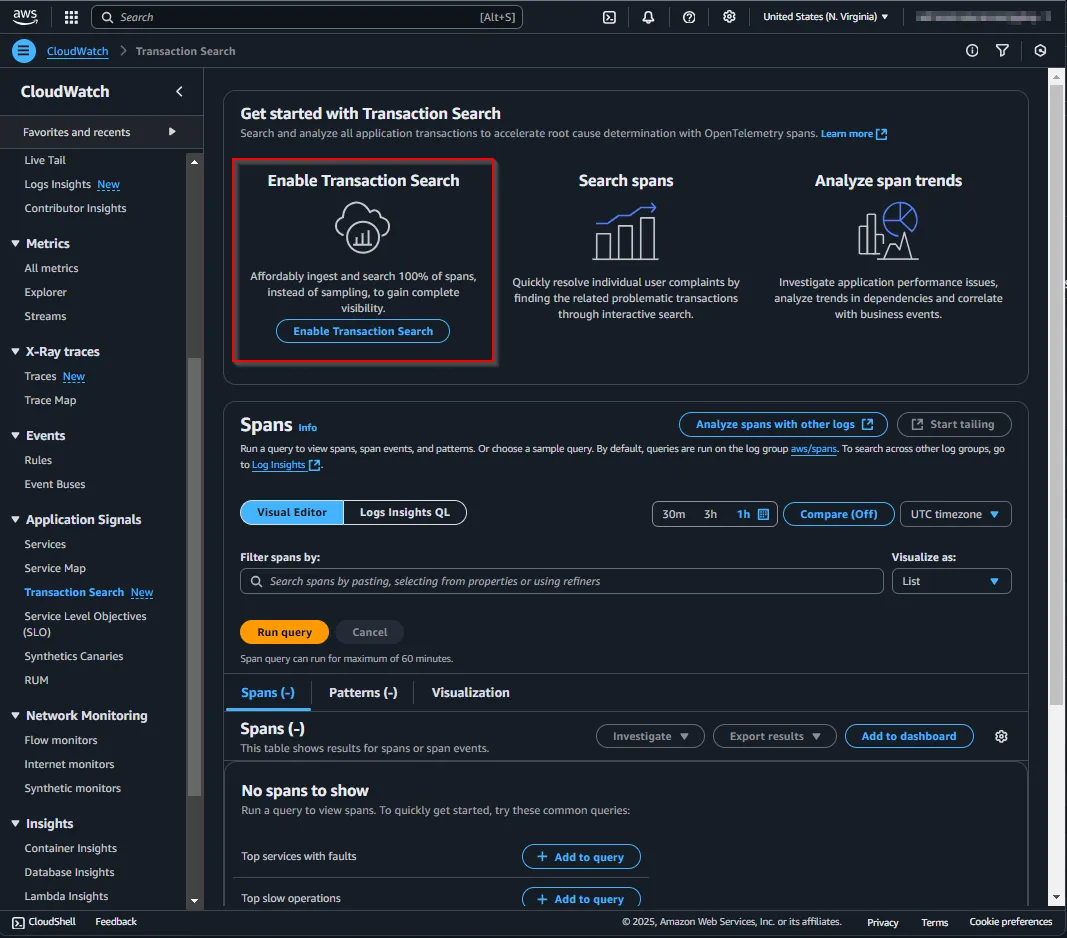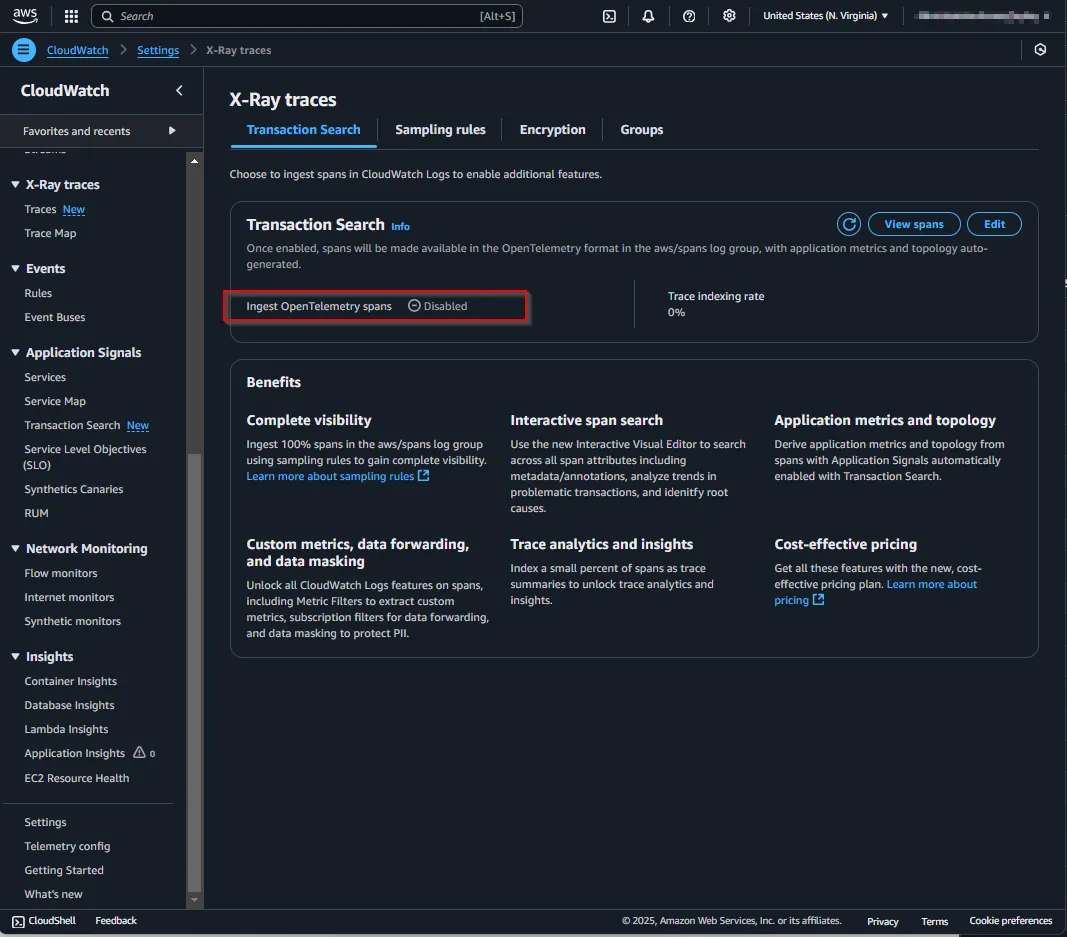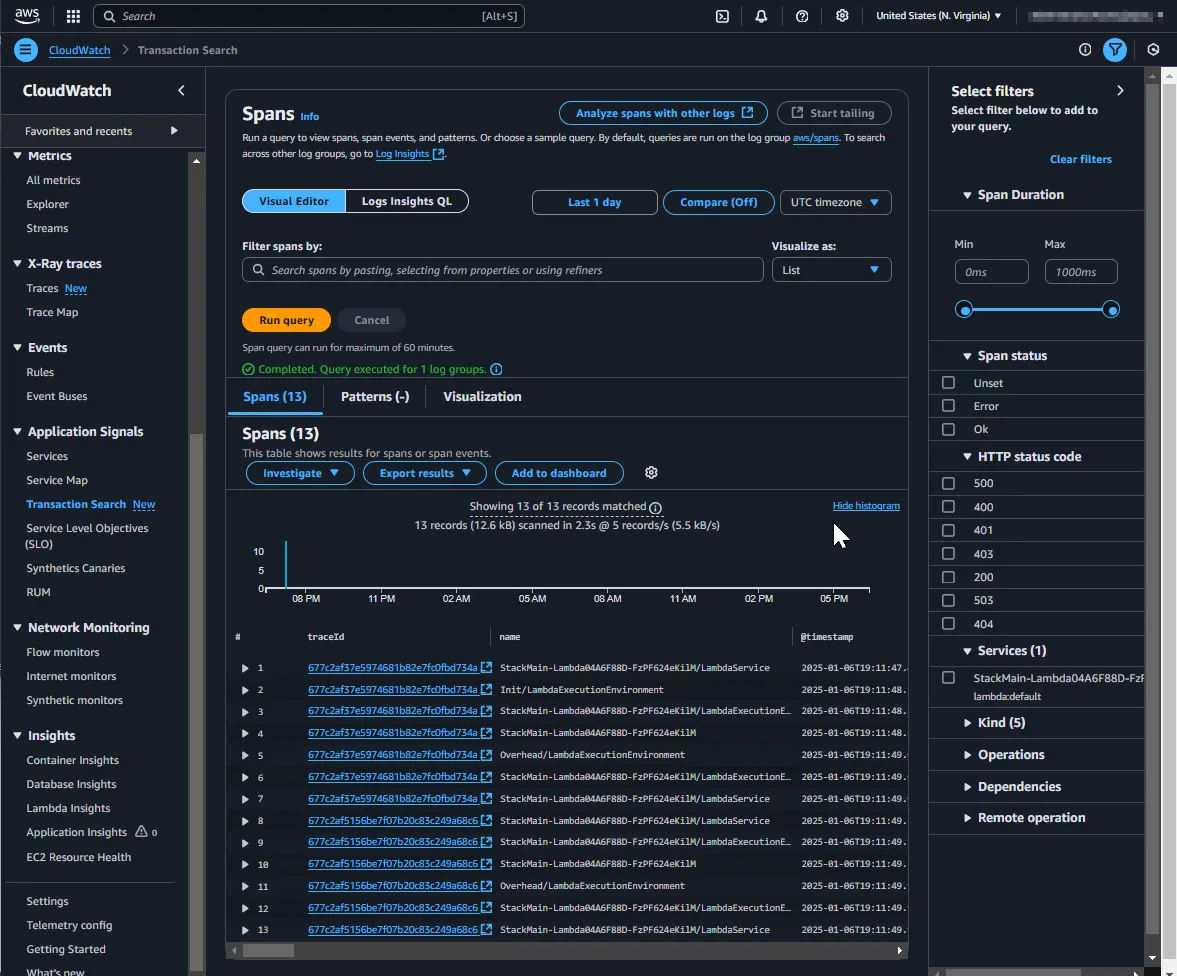Update 2025-06-18: Provisioning with CloudFormation
Recently, AWS added native CloudFormation support for provisioning Application Signals Transaction Search. You can find the official documentation here:
Here is an example of how to implement it in the AWS CDK:
import { CfnTransactionSearchConfig } from "aws-cdk-lib/aws-xray";
import { CfnResourcePolicy } from "aws-cdk-lib/aws-logs";
const { account, partition, region } = Stack.of(this);
const transactionSearchAccess = new CfnResourcePolicy(
this,
"XRayLogResourcePolicy",
{
policyName: "TransactionSearchAccess",
policyDocument: JSON.stringify({
Version: "2012-10-17",
Statement: [
{
Sid: "TransactionSearchXRayAccess",
Effect: "Allow",
Principal: {
Service: "xray.amazonaws.com",
},
Action: "logs:PutLogEvents",
Resource: [
`arn:${partition}:logs:${region}:${account}:log-group:aws/spans:*`,
`arn:${partition}:logs:${region}:${account}:log-group:/aws/application-signals/data:*`,
],
Condition: {
ArnLike: {
"aws:SourceArn": `arn:${partition}:xray:${region}:${account}:*`,
},
StringEquals: {
"aws:SourceAccount": account,
},
},
},
],
}),
},
);
const transactionSearchConfig = new CfnTransactionSearchConfig(
this,
"XRayTransactionSearchConfig",
{
indexingPercentage: 100,
},
);
transactionSearchConfig.node.addDependency(transactionSearchAccess);⚠️ To avoid the following error, you must first update the X-Ray segment destination to XRay before creating the Transaction Search Config again with CloudFormation:
aws xray update-trace-segment-destination --destination XRayWithout this step, you may encounter this error:
1:24:42 PM | CREATE_FAILED | AWS::XRay::TransactionSearchConfig | ApplicationsSignal...archConfigF88EF961
Resource handler returned message: "null" (RequestToken: 94079df2-4a8f-2771-a3e4-03eb0ccbc436, HandlerErrorCode: AlreadyExists)(The rest of this post describes the original method using custom resources, which is still useful for understanding the underlying API calls.)
Use Case
This guide is for you if you want to use AWS CloudWatch Application Signals Transaction Search and your Infrastructure as Code (IaC) is based on the AWS CDK.
Setup
This is how the Transaction Search page looks when it’s not yet configured:

And this is how it appears in the X-Ray settings:

The official AWS documentation outlines the steps to enable Transaction Search here: https://docs.aws.amazon.com/AmazonCloudWatch/latest/monitoring/CloudWatch-Transaction-Search-getting-started.html#w24aac24c21c13b9
While the documentation provides AWS CLI commands, this post will show you how to implement the same configuration using AWS CDK Custom Resources for a true Infrastructure as Code approach.
The complete CDK implementation using custom resources looks like this:
const { account, region } = Stack.of(this);
// https://docs.aws.amazon.com/AmazonCloudWatch/latest/monitoring/CloudWatch-Transaction-Search-getting-started.html#w24aac24c21c13b9
const applicationSignalsTransactionSearchLogsResourcePolicy =
new AwsCustomResource(
this,
"ApplicationSignalsTransactionSearchLogsResourcePolicy",
{
onCreate: {
service: "@aws-sdk/client-cloudwatch-logs",
action: "PutResourcePolicy",
parameters: {
policyName: "ApplicationSignalsTransactionSearchLogsResourcePolicy",
policyDocument: JSON.stringify({
Version: "2012-10-17",
Statement: [
{
Sid: "TransactionSearchXRayAccess",
Effect: "Allow",
Principal: {
Service: "xray.amazonaws.com",
},
Action: ["logs:PutLogEvents", "logs:CreateLogStream"],
Resource: [
`arn:aws:logs:${region}:${account}:log-group:aws/spans:*`,
`arn:aws:logs:${region}:${account}:log-group:/aws/application-signals/data:*`,
],
Condition: {
ArnLike: {
"aws:SourceArn": `arn:aws:xray:${region}:${account}:*`,
},
StringEquals: {
"aws:SourceAccount": account,
},
},
},
],
}),
},
physicalResourceId: PhysicalResourceId.of(
"ApplicationSignalsTransactionSearchLogsResourcePolicy",
),
},
policy: AwsCustomResourcePolicy.fromSdkCalls({
resources: AwsCustomResourcePolicy.ANY_RESOURCE,
}),
},
);
const applicationSignalsTransactionSearchXraySegmentDestination =
new AwsCustomResource(
this,
"ApplicationSignalsTransactionSearchXraySegmentDestination",
{
onCreate: {
service: "@aws-sdk/client-xray",
action: "UpdateTraceSegmentDestination",
parameters: {
Destination: "CloudWatchLogs",
},
physicalResourceId: PhysicalResourceId.of(
"ApplicationSignalsTransactionSearchXraySegmentDestination",
),
},
installLatestAwsSdk: true,
policy: AwsCustomResourcePolicy.fromStatements([
new PolicyStatement({
effect: Effect.ALLOW,
actions: ["logs:PutRetentionPolicy"],
resources: [
`arn:aws:logs:${region}:${account}:log-group:aws/spans:log-stream:`,
],
}),
new PolicyStatement({
effect: Effect.ALLOW,
actions: ["xray:UpdateTraceSegmentDestination"],
resources: ["*"],
}),
]),
},
);
applicationSignalsTransactionSearchXraySegmentDestination.node.addDependency(
applicationSignalsTransactionSearchLogsResourcePolicy,
);
const applicationSignalsTransactionSearchXrayIndexRule = new AwsCustomResource(
this,
"ApplicationSignalsTransactionSearchXrayIndexRule",
{
onCreate: {
service: "@aws-sdk/client-xray",
action: "UpdateIndexingRule",
parameters: {
Name: "Default",
Rule: {
Probabilistic: {
DesiredSamplingPercentage: 100,
},
},
},
physicalResourceId: PhysicalResourceId.of(
"ApplicationSignalsTransactionSearchXrayIndexRule",
),
},
installLatestAwsSdk: true,
policy: AwsCustomResourcePolicy.fromSdkCalls({
resources: AwsCustomResourcePolicy.ANY_RESOURCE,
}),
},
);
NagSuppressions.addResourceSuppressions(
[
applicationSignalsTransactionSearchXraySegmentDestination,
applicationSignalsTransactionSearchLogsResourcePolicy,
applicationSignalsTransactionSearchXrayIndexRule,
],
[
{
id: "AwsSolutions-IAM5",
reason: "CDK managed policy",
},
],
true,
);It consists of the following steps:
- Update the CloudWatch Logs Resource Policy.
- Update the X-Ray settings.
Update the CloudWatch Logs Resource Policy
The official documentation found here is slightly misleading in a couple of areas. First, the aws:SourceArn condition should use the xray service principal (arn:partition:xray:region:account-id:*), not logs. Second, the Action requires both logs:PutLogEvents and logs:CreateLogStream permissions.
const applicationSignalsTransactionSearchLogsResourcePolicy =
new AwsCustomResource(
this,
"ApplicationSignalsTransactionSearchLogsResourcePolicy",
{
onCreate: {
service: "@aws-sdk/client-cloudwatch-logs",
action: "PutResourcePolicy",
parameters: {
policyName: "ApplicationSignalsTransactionSearchLogsResourcePolicy",
policyDocument: JSON.stringify({
Version: "2012-10-17",
Statement: [
{
Sid: "TransactionSearchXRayAccess",
Effect: "Allow",
Principal: {
Service: "xray.amazonaws.com",
},
Action: ["logs:PutLogEvents", "logs:CreateLogStream"],
Resource: [
`arn:aws:logs:${region}:${account}:log-group:aws/spans:*`,
`arn:aws:logs:${region}:${account}:log-group:/aws/application-signals/data:*`,
],
Condition: {
ArnLike: {
"aws:SourceArn": `arn:aws:xray:${region}:${account}:*`,
},
StringEquals: {
"aws:SourceAccount": account,
},
},
},
],
}),
},
physicalResourceId: PhysicalResourceId.of(
"ApplicationSignalsTransactionSearchLogsResourcePolicy",
),
},
policy: AwsCustomResourcePolicy.fromSdkCalls({
resources: AwsCustomResourcePolicy.ANY_RESOURCE,
}),
},
);Update the X-Ray Settings
The two API calls for X-Ray are mostly straightforward. The only nuance is that the UpdateTraceSegmentDestination and UpdateIndexingRule actions require a recent version of the AWS SDK, as they were introduced in v3.698.0. Therefore, we must set installLatestAwsSdk: true on the custom resource.
const applicationSignalsTransactionSearchXraySegmentDestination =
new AwsCustomResource(
this,
"ApplicationSignalsTransactionSearchXraySegmentDestination",
{
onCreate: {
service: "@aws-sdk/client-xray",
action: "UpdateTraceSegmentDestination",
parameters: {
Destination: "CloudWatchLogs",
},
physicalResourceId: PhysicalResourceId.of(
"ApplicationSignalsTransactionSearchXraySegmentDestination",
),
},
installLatestAwsSdk: true,
policy: AwsCustomResourcePolicy.fromStatements([
new PolicyStatement({
effect: Effect.ALLOW,
actions: ["logs:PutRetentionPolicy"],
resources: [
`arn:aws:logs:${region}:${account}:log-group:aws/spans:log-stream:`,
],
}),
new PolicyStatement({
effect: Effect.ALLOW,
actions: ["xray:UpdateTraceSegmentDestination"],
resources: ["*"],
}),
]),
},
);
applicationSignalsTransactionSearchXraySegmentDestination.node.addDependency(
applicationSignalsTransactionSearchLogsResourcePolicy,
);
const applicationSignalsTransactionSearchXrayIndexRule = new AwsCustomResource(
this,
"ApplicationSignalsTransactionSearchXrayIndexRule",
{
onCreate: {
service: "@aws-sdk/client-xray",
action: "UpdateIndexingRule",
parameters: {
Name: "Default",
Rule: {
Probabilistic: {
DesiredSamplingPercentage: 100,
},
},
},
physicalResourceId: PhysicalResourceId.of(
"ApplicationSignalsTransactionSearchXrayIndexRule",
),
},
installLatestAwsSdk: true,
policy: AwsCustomResourcePolicy.fromSdkCalls({
resources: AwsCustomResourcePolicy.ANY_RESOURCE,
}),
},
);Result
After deploying the CDK stack and waiting a few minutes, Transaction Search will be enabled and visible in the AWS Management Console.


